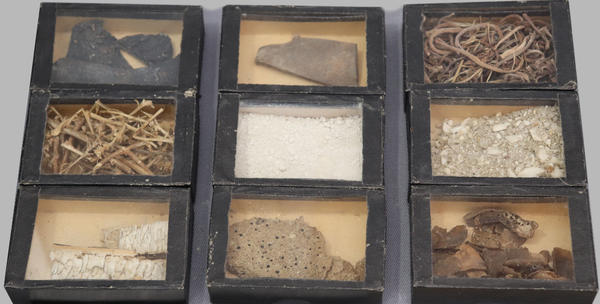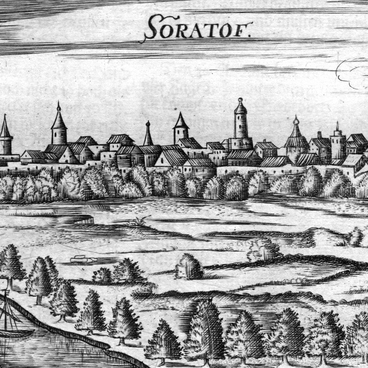The exhibition showcases food substitutes that were used by people who were suffering from starvation in Saratov Province in the early 1920s. These are boiled sheepskin, yellow dock, white clay, potato peel, powdered bones, and thorns. The substitutes were packed into boxes with glass covers.
The exhibits were stored in the Museum of Hunger. This unique museum originated in Saratov in October 1921, after a group of ethnographic students petitioned the Saratov Provincial Commission for Famine Relief, offering to open a ‘Department of a Hungry Year’ at the Ethnographic Museum in Saratov. The exhibits included photographs, documents, information tables, and food substitutes. The museum’s exposition reflected the unprecedented widescale famine of 1921, which was caused by drought and repressive food policies. In Saratov Province, 37% of the population suffered from starvation. By the spring of 1922, this figure had shot up to 68%. The Trans-Volga districts - Pokrovskiy, Novouzenskiy, and Dergachyovskiy - were in the toughest situation, and there the number of people suffering from hunger reached 90%.
In the summer of 1921, a Central Commission for Famine Relief was set up. A similar commission was created in November 1921 in Saratov Province. All of its work was done under the slogan: “Let ten well-fed people feed one hungry one.” Two thousand cafeterias were opened using money from the provincial commission. In addition, people were given basic dry food allowances. International organizations also provided substantial assistance in the fight against hunger. The well-known Norwegian scientist Fridtjof Nansen, a member of the International Commission for Famine Relief, became the main commissioner to help provide relief to our country. He traveled throughout America and Europe, appealing to organizations and various individuals for help. As a result, tens of millions of dollars were collected. In November 1921, Nansen arrived in Saratov to determine the scale of the famine in the Volga region, and to organize assistance for the hungry. Thanks to Nansen’s appeals to European governments and nongovernmental organizations, several foreign organizations started working in the province to help the hungry. The largest of those include: The International Save the Children Union, the International Workers Committee, the German Red Cross, and the American Relief Administration.
The exhibits were stored in the Museum of Hunger. This unique museum originated in Saratov in October 1921, after a group of ethnographic students petitioned the Saratov Provincial Commission for Famine Relief, offering to open a ‘Department of a Hungry Year’ at the Ethnographic Museum in Saratov. The exhibits included photographs, documents, information tables, and food substitutes. The museum’s exposition reflected the unprecedented widescale famine of 1921, which was caused by drought and repressive food policies. In Saratov Province, 37% of the population suffered from starvation. By the spring of 1922, this figure had shot up to 68%. The Trans-Volga districts - Pokrovskiy, Novouzenskiy, and Dergachyovskiy - were in the toughest situation, and there the number of people suffering from hunger reached 90%.
In the summer of 1921, a Central Commission for Famine Relief was set up. A similar commission was created in November 1921 in Saratov Province. All of its work was done under the slogan: “Let ten well-fed people feed one hungry one.” Two thousand cafeterias were opened using money from the provincial commission. In addition, people were given basic dry food allowances. International organizations also provided substantial assistance in the fight against hunger. The well-known Norwegian scientist Fridtjof Nansen, a member of the International Commission for Famine Relief, became the main commissioner to help provide relief to our country. He traveled throughout America and Europe, appealing to organizations and various individuals for help. As a result, tens of millions of dollars were collected. In November 1921, Nansen arrived in Saratov to determine the scale of the famine in the Volga region, and to organize assistance for the hungry. Thanks to Nansen’s appeals to European governments and nongovernmental organizations, several foreign organizations started working in the province to help the hungry. The largest of those include: The International Save the Children Union, the International Workers Committee, the German Red Cross, and the American Relief Administration.



